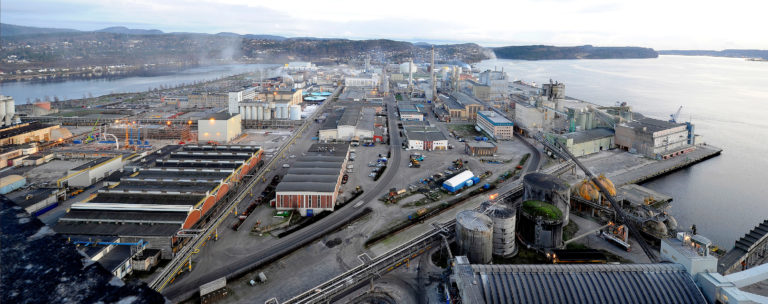1988 – Present day
Divisionalisation and steel crisis
In 1988, the Norwegian authorities decided to discontinue ore-based steel production and concentrate scrap-based production in one factory – at Mo i Rana.
The decision came after more than ten years of restructuring in the international steel industry following the steel crisis of 1975.
Up to 1975, the world’s steel production rose steadily and regularly in line with economic growth. But the idyll was not to last and in the mid-seventies, steel consumption flattened out at approx. 700 million t per year.
Steelworks found themselves struggling with the worst economic crisis in the West since the hard times of the thirties.
In 1979, the Norwegian Parliament passed the 1980-1984 plan. The aim was to increase Jernverket’s profitability by higher and more efficient production. However, expanding into new export markets was to prove very difficult. The steel market was strictly regulated by import controls and other measures. Any encroachment on another country’s territory was met by immediate counter-measures. The system was jokingly referred to as the “balance of terror”, and in this struggle, Norsk Jernverket was a mere sparrow among hawks. In October 1987, the consultancy firm Habberstad and Hartmark Iras submitted a series of reports.
Jernverket’s strategic weaknesses again came under the spotlight. The steel base was too small compared with the ore-based works on the Continent, the electrometallurgical crude iron was in low demand for high-value products, there was severe over-capacity of scrap-based steel in the group and costs had to come down. The consultants proposed a series of alternatives ranging from full closure to full operation. Jernverket presented its own proposal and it was this which gained approval.
The winter and spring of 1988 were fateful times for the Rana community. The workforce of both the Ironworks and the Cokeworks prepared for battle in a matter on which their future depended. Threatening clouds loomed on the horizon. There were long processions of demonstrating workers. Many felt that the downturn had already arrived and some had already packed up and were ready to go.
On 9 June 1988, Parliament voted to discontinue state ownership of Norsk Jernverket as part of a comprehensive reorganisation of state-owned industry at Mo i Rana.
Out in the world, time-honoured steelworks towns had fallen into ruins in the wake of the steel crisis. Rana had to escape such a fate. In addition to the reorganised cornerstone of Norsk Jernverk, the municipality was to be given new foundation stones on which to build. Parliament agreed 983 million kroner for restructuring of the Jernverket Group. To establish new businesses in Rana, a “Rana package” of 500 million kroner was granted, together with laid-off workers from the ironworks and reduced employer contributions over 5 years. Rana was now once again facing a dramatic reorganisation.
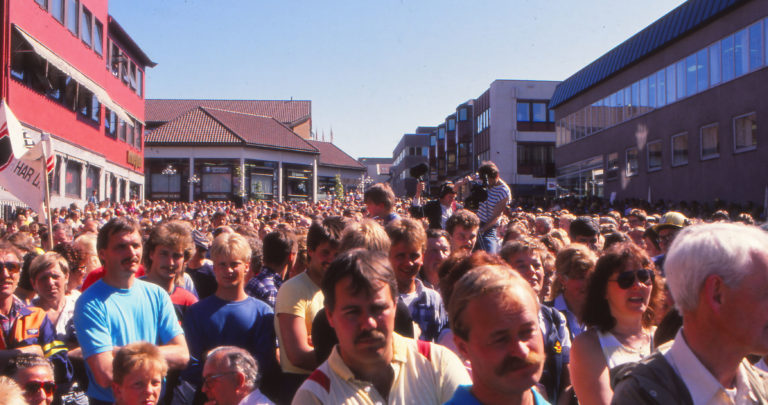
Demonstration 1989
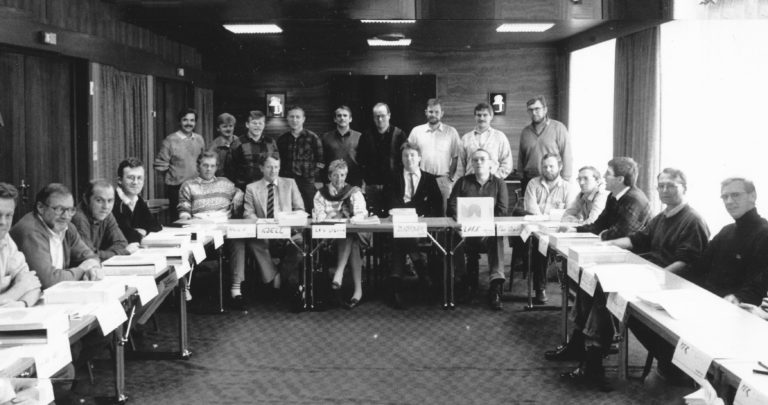
Reorganisation and privatisation
The separation of Mo Industripark AS and Mo Industrial Park occurred as part of the closure of AS Norsk Jernverk.
A large part of the infrastructure – buildings, roads and plant – was transferred from Norsk Jernverk to Mo Industripark AS which rents this out to the companies in the Mo Industrial Park. At AS Norsk Jernverk, the state had owned and managed all activities. Today, different companies run the transport tasks, steel production and other aspects.
The difference between Mo Industripark AS and Mo Industripark
There are several reasons why the reorganisation at Rana has succeeded:
– First of all, there is the combination of political boldness at the national level with the favourable conditions at Rana stemming from the high levels of technical and industrial expertise. Once the decision had been taken, there was also wide local acceptance. The locals pressed on and made great personal efforts to make the thing succeed.
– There was a willingness to supply the necessary resources, both in capital and in access to electric power. This was then channelled through a good local innovation organisation.
– Finally Rana also enjoyed its share of good luck. The time was favourable and a number of decisions were taken which turned out right. All in all, this brought Rana and its industry into a very favourable trend of events.
The background for the reorganisation was the government’s wish to abandon the role of dominant industrial owner. The international “rules of the road” were in a period of flux, not least because of the fall of the Soviet Union and Norway’s accession to the EEZ treaty. Moreover, the European steel industry had undergone extensive reorganisation for ten years, leading to an international ban on state-supported industry.
The reorganisation of industry at Rana was in large part a combination of thorough-going outsourcing, successful privatisation and later also internationalisation.
Where once there was only one company, there are now over a hundred, operated at a high level of efficiency and innovation. This is the foundation for the industrial park concept.
What is an industrial park?
The industrial park concept means that the individual company can concentrate fully on its core business, while most of the practical details are already catered for. In the immediate vicinity are companies offering services such as maintenance, ICT, energy, engineering, logistics, accountancy, cleaning, architecture, constructional solutions and much more. There is a clear financial benefit in sharing a common infrastructure and services.
At the same time, competition is free, and each company is able to choose its own business partners. This adds up to a healthy and efficient operating form in which both suppliers and customers enjoy the conditions for favourable development of their own business. At the same time, some tasks are so great or diverse that they can only be solved together with others. In the industrial park, this is achieved by joint invitations to tender, network cooperation and supplier development.
New processing industries and the growth of engineering industries
Ferroalloys
Following the reorganisation, the crude iron works was converted to produce ferroalloys. On 31 January 1989, demolition started on furnaces 5 and 6. After a full rebuilding of furnace 6, Rana Metall – later Fesil Rana Metall – was able to power up the furnace, and from autumn 1989 the production of ferrosilicon was under way. By the beginning of February 1990, furnace 5 was complete and thus both furnaces were in full-time operation.
The plan was to use the four smallest furnaces to produce ferrochrome (Norsk Ferrokrom) and other ferrous products (Norsk Ferro). These had a short life and were taken over by Elkem as early as May 1990. Elkem Rana then began production of ferrochrome. Elkem operated this business until June 2002. In February 2003, the major Brazilian group CVRD (later Vale) bought the smelting work from Elkem. After rebuilding and modernisation of the smelting furnaces, sinter works and raw materials store, production began of manganese alloys. The Rana company was named Rio Doce Manganese Norway, which changed to Vale Manganese Norway in spring 2009. Vale sold the company to Glencore in November 2012, and the company continues with the same product range under the name Glencore Manganese Norway.
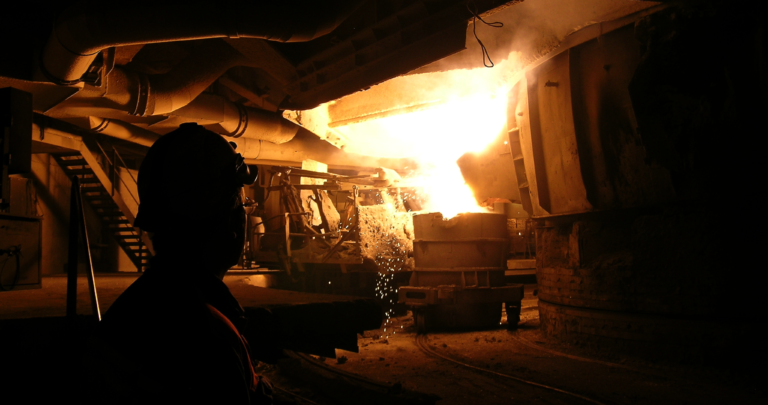
Miras and Momek
Development of an engineering industry in Rana accelerated with the establishment of Miras AS.
Miras AS purchased a majority share in Multimaskin on 1 July 1993, and two years later acquired all shares in the company. At this time Miras owned a large proportion of the engineering industry in the Helgeland district.
The owner of Miras was Rana Invest (RI), and RI and Miras also had the majority share in companies such as Grotnes Verksted AS, Rana Hydraulikk AS, and Excon AS in Sandnessjøen.
These companies developed into the Miras Group, which became Northern Norway’s largest engineering group.
In May 1998, three young men started their own company, Mo Mekaniske Verksted AS. In just a short time, the company had grown to 12 employees. Wiggo Dalmo was the front man for the young, expansive company, later renamed Momek Group AS.
Growth at Momek, as the company was popularly called, continued in the following years, and soon younger brother Momek started to challenge big brother Miras.
At the start of 2012, three of the companies in the Miras Group went into liquidation, and three others ceased operation: Miras, Miras Multimaskin and Miras Vedlikehold og Modifikasjon, together with the Miras Group. After a restructuring which lasted over two years, the Miras Group today (2014) consists of Miras Solutions and Miras Grotnes.
At the same time, Momek Group took over the role of “big brother” and grew into the leading engineering group in Northern Norway.
There are also several other engineering companies in Mo Industrial Park, including Imtas and IMO Sveiseindustri.
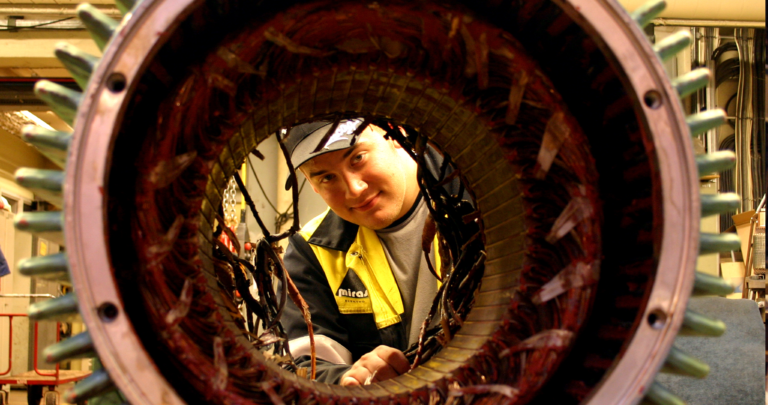
Living industry
Unlike AS Norsk Jernverk, all operations are conducted on commercial principles. In 2010 the old shape rolling mill, owned by Rautarukki AS, was closed down after 50 years of service. In 2012, Vale Manganese changed owner to Glencore. Some companies disappear, others change owners and others grow in size. The 2008 financial crisis was a hard blow for the industries at Rana, but the number of employees equals that of the Jernverket era. Work is still being done on new projects and opportunities which could create further activity in the future for Mo Industrial Park.
Work is proceeding on several fronts in different projects which could create further activity in Mo Industrial Park.
Further sources on the later industrial history of Rana
– Ore, power and people: a history of Rana 1890-2005 / Hilde Gunn Slottemo 2007 (in Norwegian)
-Local reorganisation: an analysis of local and structural conditions for reorganisation in municipalities dependent on single industries: the example of Rana/ by Inga Lena Grønlund (1997) (in Norwegian)
-Dreams of steel: A/S Norsk Jernverk from the 1940’s to the 1970’s / Anne Kristine Børresen 1995 (in Norwegian)
– From one industry to many: Follow-up report no. 3 on employment development in Rana / by Inga Lena Grønlund (1993) (in Norwegian)
– From one industry to many: Follow-up report no. 2 on employment development in Rana / by Even Høydahl and Inga Lena Grønlund (1992) (in Norwegian)

